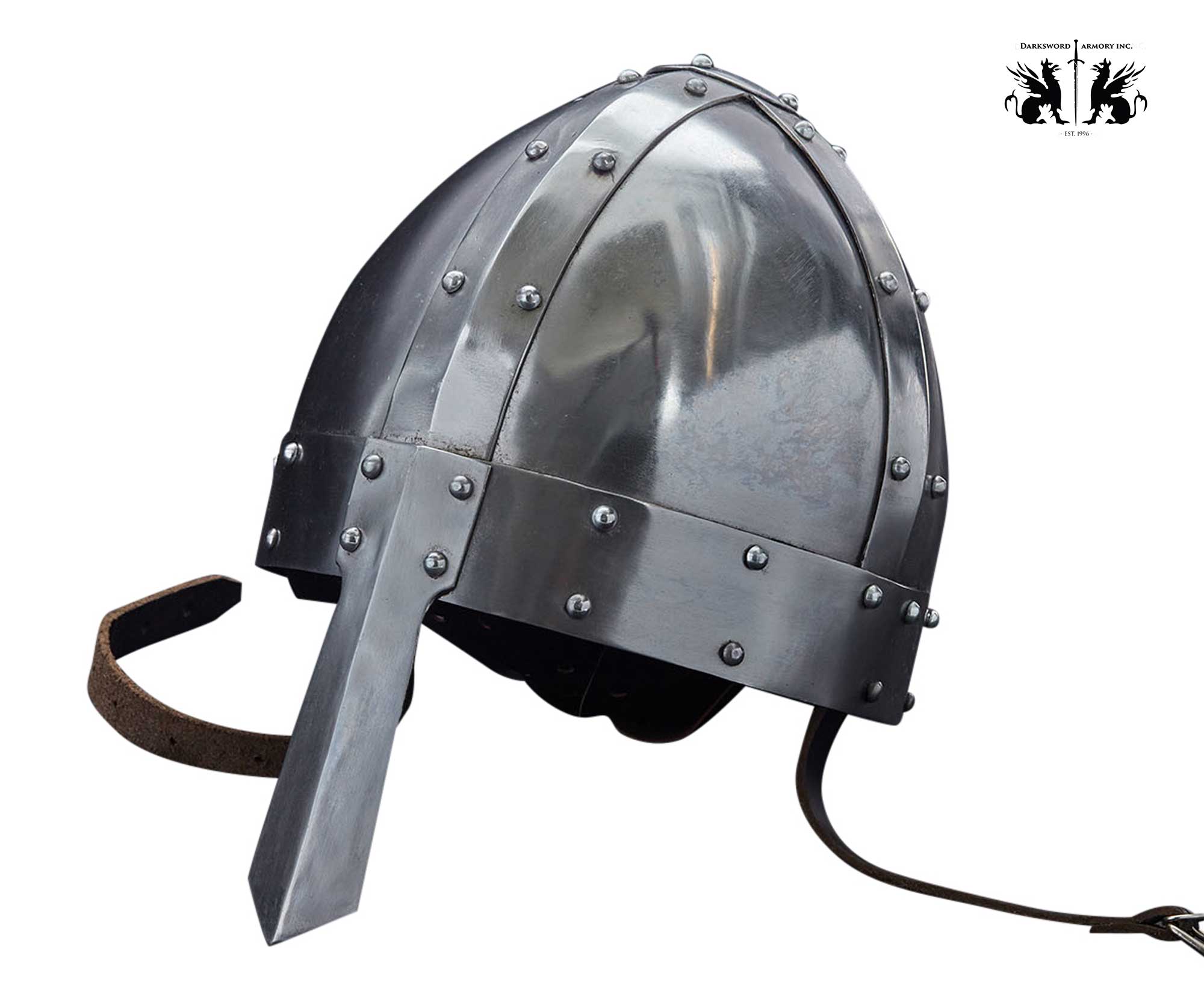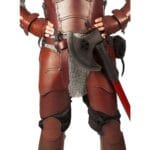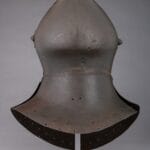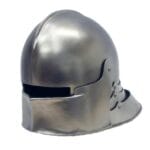Unraveling the Spangenhelm: A Segmented Marvel
The spangenhelm, a helmet as intriguing as its name, stands as a testament to the ingenuity of early medieval armorers. Unlike helmets forged from a single piece of metal, the spangenhelm is constructed from interconnected plates, a design that offers a unique blend of protection, adaptability, and historical significance. From the Eurasian steppes to the battlefields of Europe, the spangenhelm’s journey through time reveals a story of evolving craftsmanship, cultural exchange, and enduring legacy. Explore our wide selection of tassets to enhance your historical reenactment experience and step into the shoes of a medieval warrior.
Origins and Dissemination: From Steppe to Battlefield
The spangenhelm’s story begins in the 6th century CE amidst the nomadic Iranian tribes of the Eurasian steppes, groups like the Scythians and Sarmatians. These mobile warriors, ever in motion across vast distances, likely found the spangenhelm’s segmented construction ideal for their lifestyle—offering robust protection without excessive weight. From this point of origin, the spangenhelm’s influence radiated outwards, becoming a common sight across Europe and the Middle East. This widespread adoption suggests not only the helmet’s effectiveness but also the interconnectedness of cultures during this period. The spangenhelm’s journey from the steppes to the heart of medieval Europe speaks volumes about the exchange of ideas and technologies that shaped the era.
Construction and Variations: A Craftsman’s Endeavor
The spangenhelm’s name, derived from the German words “Spangen” (braces) and “Helm” (helmet), speaks to its defining feature: the metal strips or rivets that bind its constituent plates. Typically crafted from iron or bronze, these plates, usually numbering between three and six, were meticulously shaped and joined to form a conical structure that conformed to the wearer’s head. This segmented design allowed for variations in construction, some featuring a single central band, others a more complex framework. Furthermore, the spangenhelm could be customized with additional features: a nasal guard to protect the nose, cheek flaps of metal or leather, an aventail of chainmail to defend the neck, and even, in some cases, rudimentary eye protection in the form of “spectacle helmets” or full face masks. Indulge in the sensual allure of a voyeuse chair and captivate your senses with an intimate experience designed to ignite your desires.
Advantages and Drawbacks: A Balanced Perspective
The spangenhelm’s segmented construction offered distinct advantages. Its relative ease of production, compared to more complex helmet designs, probably made it more accessible and affordable for equipping larger groups of warriors. Moreover, the gaps between the plates might have provided some ventilation, a welcome feature in the heat of battle. However, these very segments could also prove to be a weakness. The joins between the plates were potential points of vulnerability, susceptible to piercing blows. While offering decent protection overall, the spangenhelm’s design represented a compromise between defense, cost, and comfort.
Evolution and Influence: A Lasting Impression
As the medieval period progressed, newer helmet designs, such as the nasal helm, kettle hat, and great helm, gradually superseded the spangenhelm on the battlefield. These later helmets, often constructed from a single piece of metal, offered more comprehensive head and face protection. However, the spangenhelm’s influence didn’t simply vanish. Depictions in later medieval art, notably the Bayeux Tapestry (11th century) and the Morgan Bible (13th century), feature helmets that bear a striking resemblance to spangenhelm construction. Whether these depictions represent true spangenhelms, transitional forms, or simply artistic interpretations, they suggest that the spangenhelm’s legacy extended beyond its period of widespread use, leaving a mark on the visual language of medieval warfare.
The Spangenhelm and the Vikings: An Ongoing Debate
The question of whether Vikings wore spangenhelms is a subject of ongoing scholarly discussion. While definitive archaeological evidence of widespread Viking adoption of the spangenhelm remains relatively scarce, artistic depictions in Viking art, such as carvings and illustrations, show warriors wearing helmets that resemble spangenhelms. This raises the possibility that some Vikings, particularly those with the means or through cultural exchange, might have acquired and utilized them. The Vikings’ extensive travels and interactions with other cultures, some of whom readily employed spangenhelms, certainly provided opportunities for such acquisitions. However, it’s crucial to acknowledge the artistic license often taken in historical depictions, which can complicate interpretations. The limited archaeological findings, coupled with the ambiguous nature of artistic representations, make it challenging to definitively determine the prevalence of spangenhelm usage among Viking warriors. Further research and new discoveries may yet shed more light on this fascinating aspect of Viking material culture.
Who Wore the Spangenhelm? A Diverse Array of Warriors
The spangenhelm was not limited to a single group but adorned the heads of various warriors across different cultures and time periods. From the nomadic Iranian tribes who likely pioneered its use, to the Vikings who may have adopted or adapted the design, and even medieval knights, particularly the Normans, the spangenhelm found favor across a diverse spectrum of military traditions. Interestingly, the concept of a segmented helmet appears in other parts of the world, suggesting potential cross-cultural exchange of ideas or independent invention. The spangenhelm’s widespread use underscores its effectiveness as a protective headgear in the context of early medieval warfare.
The Purpose of the Spangenhelm: Protection in Battle
The primary function of the spangenhelm was to provide head protection in combat. Its segmented design, while potentially creating weak points at the joins, offered a practical balance between defense and ease of production. This made it a viable option for equipping larger numbers of warriors. The spangenhelm’s prevalence during the Early Middle Ages highlights its importance as a piece of military equipment, contributing to the evolution of helmet technology and the changing dynamics of warfare.
Ongoing Research and Unanswered Questions
While much has been learned about the spangenhelm, many questions remain open to further investigation. Ongoing research continues to explore topics such as regional variations in design, the specific techniques used in its construction, and the social implications of its adoption. As new discoveries are made and analytical techniques improve, our understanding of this iconic medieval helmet is likely to deepen and evolve, offering richer insights into the lives and battles of those who wore it.












